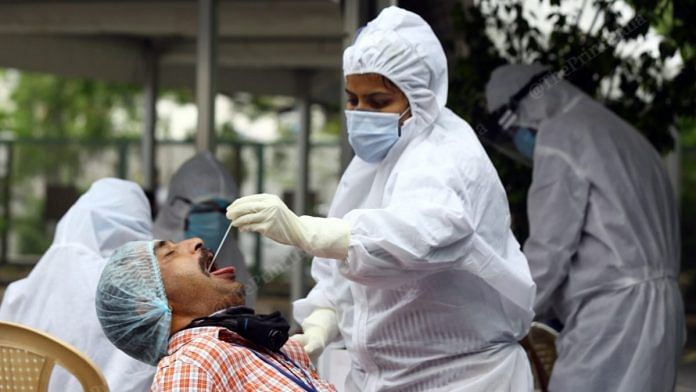This is based on an analysis of CRS data by the Union Ministry of Health and Family Welfare (MoHFW) and government think tank NITI Aayog.
Here, excess deaths refer to additional deaths that take place over and above the expected deaths, usually calculated for a non-pandemic year. “Now, based on official figures, we can say the total toll of the pandemic in the country was 15.54 lakh [for 2020-21], but it will not be appropriate to call all of these as Covid deaths because not all of them can be directly attributed to the infectious disease,” a source in the health ministry said.
The official said it was not possible to gauge exactly how many of these could have been unreported COVID deaths. According to the Union government, the official COVID-19 death toll for 2020 and 2021 stands at around 4.81 lakh.
Dr T. Sundararaman, a veteran public health specialist, said excess deaths during the COVID-19 period should be seen as the “price that the people paid for the pandemic”.
“In terms of public health it does not matter whether these deaths were directly due to Covid19 infection, unreported deaths or those due lack of access to healthcare or change in health seeking behavior- the fact remains that a huge number of excess deaths was reported during the worst Covid year, as validated by the government data now,” said Sundararaman, who previously headed the health ministry’s premier think tank the National Health Systems Resource Centre. These excess deaths, he said, should be attributed to the deadliest year of the COVID-19 pandemic.
The CRS is a compulsory, independent, and universal system for recording all births and deaths under the Registration of Births and Deaths Act, 1969. These deaths are first reported to the local registrar, based on which each state generates its respective report.
The collated data from state reports is published as the annual vital statistics report by the Registrar General of India (RGI), under the Ministry of Home Affairs (MHA).
On 7 May, RGI released the much-delayed ‘Vital Statistics of India’, based on CRS 2021, and it was used, government sources said, along with the 2020 report, to estimate excess deaths during the first two years of the COVID pandemic.
They also underlined that the number of deaths documented in the CRS had been increasing over time, even in the years preceding the COVID-19 outbreak in 2020.
The annual increase observed in a given year, compared to the previous year, has varied from 1.3 percent in 2016 to 9.93 percent in 2019, with the average increase over the three-year period preceding the pandemic years (2016 to 2019) estimated at 6.42 percent per annum.
This is attributed to several reasons, including a larger population cohort, maturing reporting processes, and increased awareness of the need for registration, leading to higher registration levels.
“This trend has been further accentuated over the years by the mandatory requirements for death certificates linked to pension schemes, social security benefits, and property issues. Besides, COVID death compensation required death certification, prompting registration under CRS,” said another senior health official.
As a result, the analysis by the ministry and NITI Aayog underlined that based on the three-year (2016-19) annual rate of increase (6.42 percent), the expected number of deaths would be 81,31,869 in 2020 and 86,54,185 in 2021.
The final Vital Statistics of India/CRS 2021 report said observed deaths were 81,15,882 in 2020 and 1,02,24,506 in 2021.
Excess deaths, calculated by deducting observed deaths from the expected deaths, were minus 15,987 and 15,70,321 for 2020 and 2021, respectively, the analysis shows.
The total excess deaths over the two-year period added up to 15,54,334, and as a percentage, this was 9.3 times higher than the expected deaths.
This translates into about 1,249 excess deaths per one million population, government sources said. “It must be emphasised that excess deaths in these years are not equal to COVID-19 direct deaths. These excess deaths include reported COVID-19 deaths (4,81,080 by the end of 2021), unreported Covid deaths, deaths due to all other causes, and possible indirect effects of the pandemic,” said one of the two officials quoted above.
The MoHFW and Niti Aayog also compared cumulative excess deaths in India for 2020 and 2021 against the excess mortality recorded in selected countries during the same period.
Excess mortality in high-income countries, expressed as a percentage as a percentage of the expected mortality, was found to be 17.6 percent in the US, 11.8 percent in Italy, 11.8 percent in the UK, 29.9 percent in Russia, 6.7 percent in France, 5.3 percent in Germany, and 5.2 percent in Canada. Among middle-income countries, excess mortality was recorded at 43.6 percent in Mexico and 12.6 percent in Brazil.
In the case of India, they stressed, this figure stood at 15.3 percent.
In 2022, the World Health Organisation (WHO), based on modelling, estimated India’s excess Covid-related deaths at 47 lakh, while another such estimation led by Washington University had said that India may have seen 41 lakh excess deaths in 2020-21.
These figures were strongly contested by the Indian government.
“But based on actual data, we can now say that the toll of the COVID-19 pandemic was less than one-third of what the WHO estimated,” one of the government officials quoted above said.
(Edited by Sanya Mathur)








